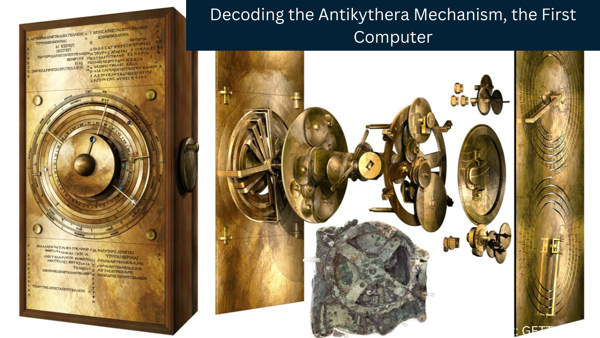
World & Indian History
Antikythera Mechanism: The Ancient Mystery Of The World's Oldest Computer
In 1901, explorers found the world's first known almost 2500 years old analog device from a shipwreck off the coast of a small island called Antikythera, ancient name Aigila, in the straits between Crete and the Peloponnese.
The shoebox-sized device is popularly known as the world's first analog computer, and it was capable of calculating the cycle of the cosmos, which includes the sun, moon, and stars, as well as measuring the governance position of cosmological objects in the coming years.
According to researchers, as that gadget was capable of tracking the position of cosmological objects, therefore, it was used to predict the time and date of athletic competitions, such as the Olympics.
The Greeks developed an excellent navigational tool, using bronze as a metal, to calculate the passage of time to point out the location of cosmological objects, as well as a positioning device to do business with neighbors of the time.
The entire device has weathered away due to salt water corrosion, but from what remains, Archaeologist Valerios Stais, on May 17, 1902, identified that the device was made up of several wheel gears, and for the time being, preliminary radiographic images show that the device was made up of at least 30 wheel gears and small leavers.
Its manufacture is currently dated between 100 and 200 BCE, but the precise time of the device's discovery has yet to be determined. The remains of the ancient computer are now on display in the National Archeological Museum in Athens.
Whoever created that technology would have required to be well-versed in astronomy, metallurgy, and machine technological know-how. The device's concept is far more advanced and complex for its time because the Cathedral Clock is the first medieval complex technology known to mankind.
When the device was first discovered in 1901, it raised several questions in the minds of people from various fields, including historians, engineers, astronomers, mathematicians, archaeologists, and others. Some questions remained unanswered until 2005, but the mystery surrounding the device was revealed when it was scanned using CT scan and 3D-Xray.
The device was engraved with a Greek inscription and writing that revealed how the device was made or constructed and how to use it. At first, researchers attempted to decipher the words but were unable to do so because they had weathered off. However, over the last decade, researchers have been able to codify the letters with the help of modern technologies, with special thanks to CT scans and 3D-Xray. This has allowed them to learn more about the mechanism's operation. Based on that, a demo version was created, but it is not yet operational due to several missing links yet to be discovered.
CT scans revealed inscriptions describing the motions of the sun, moon, and all five known planets in antiquity, as well as how they were displayed in front as an ancient Greek cosmos. The mechanism employed "cycles from Babylonian astronomy, mathematics from Plato's Academy, and ancient Greek astronomical theories," according to the researchers.
According to researchers, the front end of the device had a clock mechanism to measure the orbital movements of the moon, sun, lunar nodes, Mercury, Venus, Mars, Jupiter, and Saturn, as well as the Zodiac calendar. The back end of the mechanism had dials of the Metonic cycle (a 19-year cycle in which the phases of the moon occurred on the same days of the year), the Callippic cycle (a period of 76 years, equal to four Metonic cycles), the Olympiad cycle (when the Olympics were held every four years), the Saros cycle (a period of more than 18 years between lunar eclipses), and the exeligmos cycle (a period of more than 54 years, or three Saros cycles).
The discovery of this device gave birth to many speculations about the modern human being and related technologies, as well as some unnecessary theories that are beyond historical imagination.
The precise time period and purpose of the device have yet to be determined, but a human skull was discovered in 2016 from the same shipwreck where the device was discovered. Scientists are attempting to extract DNA from the skull in order to determine the time period of the device.
Some researchers believe that the mechanism was invented by Greek inventor Archimedes (287 B.C. to 212 B.C.), but this is uncertain and has yet to be proven. But, One question remains, and that is how advanced human civilization was during the ancient and medieval periods. The present human civilization is still waiting for a definite answer.

0 Comments